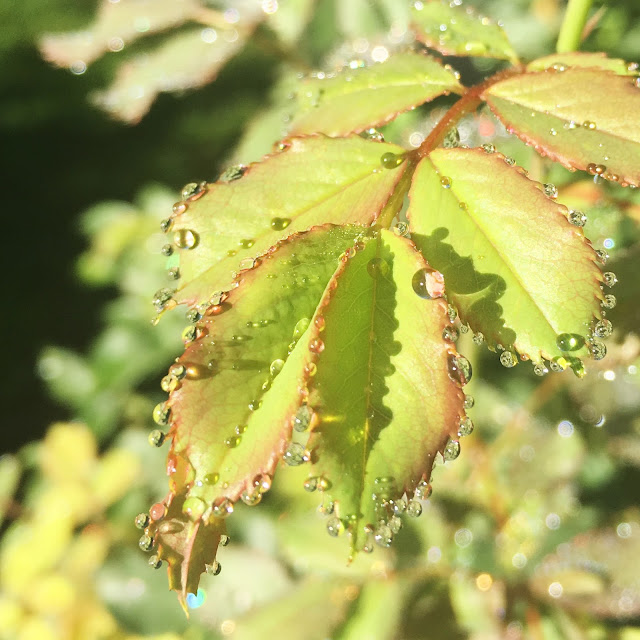I've mentioned before that the idea that a garden is ever "finished" is a fallacy. Because it is constantly growing and changing, gardens are in a state of evolution at all times. It's not like redoing a room in your house where you paint the walls, get new furniture and then stage it perfectly to take a bunch of photos because it's finished.
It's a lesson I wish I would have learned many years ago when I think I was rushing to get the garden finished. I think I made some poor design choices because of that rush, but even if I hadn't, I'm sure there would be decisions I regretted.
 |
| The circle garden from a few years ago before the chive hedge was complete and when I actually tended it a bit more. |
And that's where I am now with the oval garden. You can always tell when I'm sick of an area of the garden, or at least when it's not holding my attention, because it will be the most unkempt area of the yard. And for a couple years now, that's what the oval garden (which I often call the circle garden because it has a better ring to it even though it is certainly not a circle) has been. I just haven't loved it enough to do any more than the basics, and it shows.
 |
| I'm embarrassed to show you this photo of what the circle garden looked like this weekend before I started ripping plants out of it. What a mess. |
What really kicked my butt in gear was a really inspiring conversation I had with my friend Linda (who blogs at
Each Little World) and her husband Mark when they
stopped to see the garden in early July. They rattled off some ideas that finally got the creative juices flowing.
I've been thinking about the oval garden since then and have now committed to a complete redo next spring. First of all, I should mention, the oval garden was the first garden I made from complete scratch in my life. We had owned the house a couple years and I had reshaped and completely emptied the garden off the patio but I was anxious to get stuck into a project that was all mine. So I turned a derelict vegetable patch with random shrubs thrown in, into an oval garden. At this time I didn't have a real handle on my own garden style, and I was just getting my feet wet at learning about plants in general. In other words, I was pretty much winging it.
What has become most clear was the biggest mistake I made when I first designed it. I went with the oval shape for a handful of reasons, including that it was the most effective way to deal with the sort of rectangular leftovers of the garden that had been and because the space seemed to lend itself to something that length but didn't have room for the width that would be needed to make a circle. But I also was afraid of getting too formal and somehow I thought an oval was less formal than a circle.
 |
| This photo from Google gives the best view of the circle garden. Judging from how sparse the western most section is, I think this photo is from about two years ago when I combatted a horrible weed problem there. Just looking at those curvy paths makes me cringe. |
That's really flawed thinking of course. By it's very nature, a garden that is edged in cobblestones with center feature and self contained is going to be a more formal look. I tried to fight formality even more by dividing it into three sections of different sizes with curvy paths. Because a 6-foot long curvy path is super informal, right? And then I got greedy with planting space and made the paths very narrow, just 16 inches, because apparently at some point I thought I wouldn't have enough space for plants in my yard. Clearly I was wrong about that. Basically I did everything I could to fight formality.
Over the years I've come to terms with my divided loyalties to different gardening styles. I love a flowy, cottage-style garden, but gosh darn it, I like formal and structured too. And even though it seems odd to consider those two styles in the same place, I've also reached a point where I'm comfortable gardening for myself and have decided that if I love it, then that's what matter. It's funny: I've preached this approach dozens of times on this blog, but it has taken me a while to feel comfortable with that in my own garden.
So this fall and next spring I will be correcting some of the wrongs I made originally in the oval garden. First off, I'm going to embrace the formal nature of it, but I will be embracing some of the planting styles and choices I admire in other gardens. What exactly that will look like, I'm not sure, but here's a list of what's happening.
 |
| This is literally a picture of the quick sketch I was working that gives you an idea of what I was thinking for the paths on the redesigned "circle" garden. I'd adjust the angle of that X so that the path in the lower left would lead somewhat naturally off the patio. |
- The overall shape, center circle and exterior cobblestones will remain unchanged.
- The curvy paths will go, replaced by a much more formal X-shaped design for the paths. They will also get a bit wide to make them more comfortable to walk on and more in proportion with the garden.
- The pea gravel used for the paths is going. I've decided I detest pea gravel. A lot of people love it and good for them, but I prefer the sharper edged gray gravel I used on the path to the garage. Or I might consider something like a decomposed granite for the paths.
- The chive hedge stays. I love that chive hedge even though it's a little quirky. I'll replant it to match the new paths so that each segment is outlined in chives.
- The plan now is for the center obelisk to stay, along with the clematis that grows up it. The 'William Baffin' rose that also grows there could stay or go.
- The rhubarb will probably stay only because I can't think of a better place for it and it's quite happy there.
 |
| Quirky as it may be, I love this chive hedge and it's staying. |
I started the process of clearing out plants over the weekend. The sedum 'Autumn Joy', which I planted three of when I first made the garden and divided them over time was moved to a sunny corner of back/side yard garden. Amazingly there were at least 15 plants there. A few of the grasses were moved to the end of the driveway near the address sign to help ground that. I need to find homes for a few hydrangeas, a hosta and a handful of other plants, including a baptisia that will not appreciate the move at all. Everything else is either an annual or a plant deemed not worth saving.
Once I get the plants attended to, I'll work on ripping up the paths and repositioning them. I'd like to get all of the structural parts finished this fall so that all that is left for spring is planting. As for the the planting plan, that's up in the air. My best garden inspiration tends to happen in the middle of winter so I'm not overly concerned about that bit yet. I do know that I'd like it to be very colorful, which will help carry the garden until mid-summer when things really start blooming in my yard.
It's sort of odd to be tackling an area of my garden for the second time, but I look at how much different my perspective and knowledge is this time and I'm really looking forward to the process and the result.
Have you ever looked bad at a decision you made in your garden and wondered what you were thinking? Please tell me you have!








































